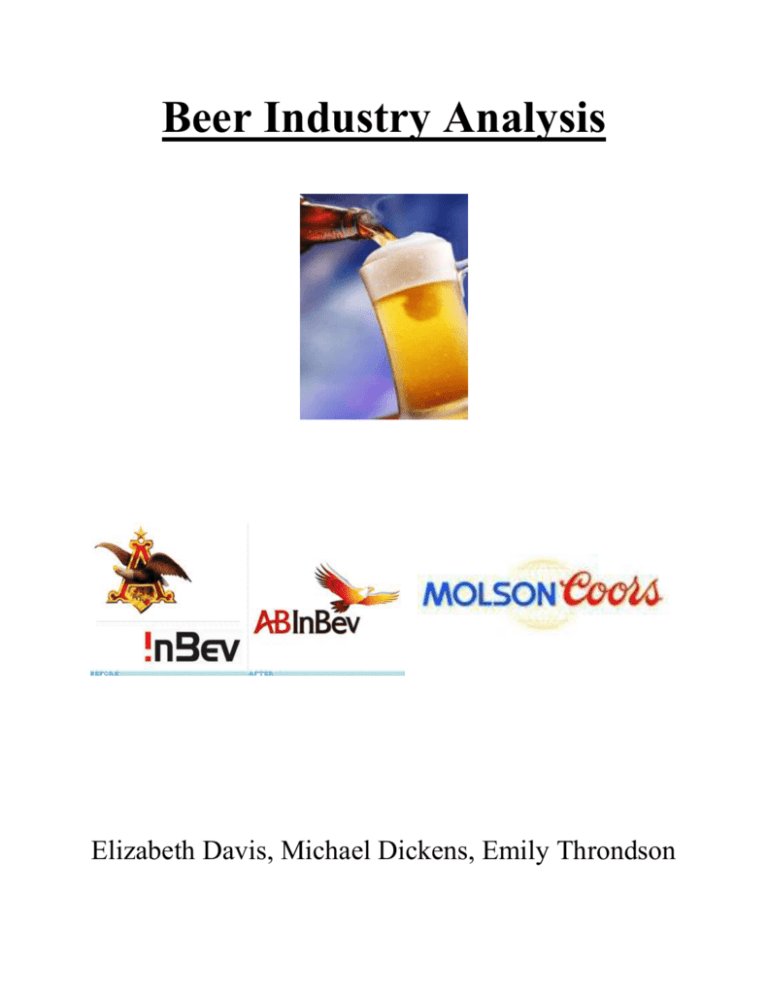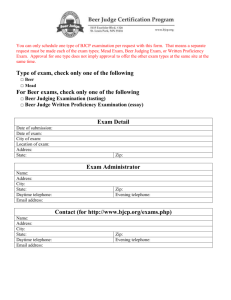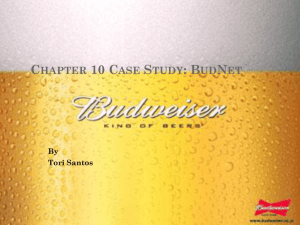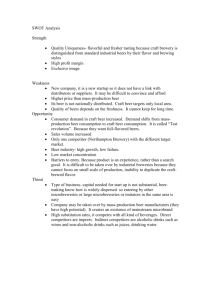Final Term Paper
advertisement

Beer Industry Analysis Elizabeth Davis, Michael Dickens, Emily Throndson Table of Contents Part I…………………………………………….2 Part II……………………………………………3 Part III…………………………………………..4 Part IV…………………………………………..9 Sources…………………………………………12 1 Part I: Describe Two Publicly Traded Business Rivals 1. In 2009 the alcohol industry had its worst beer sales since 1991 (Kwon 5). This industry is normally competitive because of its recreational nature. This is not an industry that supports a product that a customer needs, this is an industry that supports a luxury. This industry is not only competitive because it is a luxury industry, but also because of the fierce competition among rival companies (Global 13). Two companies in particular are in a very fierce rivalry. The company that holds the highest market share and sales of beer in America is Anheuser-Busch. This company has been leading the industry for years and continues to be the leader in its industry. The companies that are rivaling Anheuser-Busch are the Coors Brewing Company and Miller Brewing Company. Miller and Coors have decided to unite into a joint venture brewing companies in the American market (Molson 4). Since this is a joint venture and not a true company, MillerCoors will not be a competing company in our report, and we will inturn focus on Coors. The two companies whose rivalries will be discussed will be Anheuser-Busch and Coors Brewing Company. Anheuser-Busch was started in 1852 in the streets of St. Louis Missouri, however their most famous beer, Budweiser, was not introduced until 1876. Anheuser-Busch was the first brewery in the United States that used artificial refrigeration too keep their beer fresh. During the prohibition movement Anheuser-Busch made a variety of other products to stay in business. These products include ice cream, syrup, sodas, truck and bus bodies, and other varieties of items. In 1980 Anheuser-Busch was listed in the New York Stock Exchange (History). In 2008 a German based beer company called Inbev acquired Anheuser-Busch (Anheuser 11). In November of 2010 Anheuser-Busch held 22% of the worlds market share and 50% of the market share in North America (Stock:Anheuser-Busch). Today Anheuser-Busch produces more than 100 different types of beer and similar products, including “Bud Light” which is the bestselling beer in America. Anheuser-Busch’s corporate address is One Busch Place. St. Louis, MO 63118 (History). 2 Molson Coors Brewing Company was founded in 1873 in Golden Colorado. Molson Coors was the first brewery to develop an aluminum can, which did not have the negative effects on the taste of the beer which steel cans had before. Molson Coors also survived the prohibition movement making a variety of other products such as malted milk and drinks that tasted like beer (Adolph). In 2007 SABMiller and Molson Coors Brewing Company agreed to combine their brewing operations in the United States to try to compete with their main rival Anheuser-Busch (Global 11). In November of 2010 Molson Coors held 41% of the market share in the Canadian segment, which is its strongest market (Stock:Molson). Molson Coors corporate address is 250 South Wacker Drive, Chicago, Il 60606-5888 (Adolph). Both of these companies are engaged in the production and sales of beer and alcoholic beverages. Beer is the main focus in both of these companies, and is the reason they are such successful companies. The top three beer brands in the world belong to Anheuser-Busch and Molson Coors (Kwon 5). As mentioned earlier the beer sales for large companies are down, but the beer sales for craft beer are slowly starting to rise. Coors is taking the innovative to develop craft beers to stay in control of their market (Steverman). Since beer sales have been decreasing both companies have to take initiative to stay as the leaders of the beer business. The beer business is a subsidiary of the Alcohol industry. The alcohol industry consists of the beer, wine, and spirits (Kwon 9). This industry is distinguishable among other industries because of its high regulation and taxes (Kwon 34). This industry will be focused more on in the next section. PART II: Opportunity 1. The alcohol industry consists of three different products of alcohol. These products include wine, beer, and spirits. There are many factors that drive demand for this industry. These include the price and value of the beverages, the demographic trends and consumer attitudes, and the competition from foreign markets (Kwon 33-34). The alcohol industry is notable because of its strict limitations on products, 3 barriers setup for initial startup of brewing companies, and the considerable taxes and regulations that are associated with the industry (Kwon 34). The alcohol industry is also set apart from other industries in the fact that a successful company must be concentrated and profitable, have brand awareness, and be able to break the barriers that are set up against large-scale success (Kwon 34). Although the alcohol industry is a strict and liable industry to compete in, certain companies take the initiative and are successful. This industry analysis will be focused around the beer product that is a subsidiary of the alcohol industry. Currently the beer industry is feeling the force of recession with decreasing sales (Steverman). The beer industry might be facing a slight recession, but both the Molson Coors Brewing Company and the Anheuser-Busch Company both have proven to be successful (Kwon 7). 2. The beer product of the alcohol industry is focused in many different counties. Anheuser-Busch does business in North America, all of South America, most of Europe and Asian Pacific to name a few examples (Molson 60). The country with the largest amount of demand for the beer industry is China. China is the leader of consumption of alcohol with 309.6 units of consumption in 2009 (Global 8). Morson Coors mainly focuses on their North American market, but still export Coors Light to the China Market (Morson 15). Unfortunately for the beer industry China is only expected to grow at a moderate rate over the next 5-8 years (Global 8). Part III: Industry Analysis 1. The alcohol industry is competitive and has multiple high power threats to profit. These include the threat of suppliers, substitutes, and rivalry. The threat of buyers is moderate and the threat of entry is low. The threat of suppliers for the alcohol industry is high. Companies rely on a few key suppliers for most of the raw materials needed to produce beer. Shortages of raw materials are a concern. In the instance that there is a raw materials shortage, the suppliers will have a large amount of power and will be able to control the amount of materials for sale as well as adjust the prices as they choose (Anheuser 6). For 4 example, Molson Coors buys barley malt from two primary suppliers. It is committed to the contract until 2012 (Molson 6). In 2012 they will need to reassess the market and renegotiate the contract going forward or find new suppliers. In the alcohol industry, companies rely on a small number of suppliers to provide certain types of materials, not only raw materials, but packaging (Molson 16). This gives the suppliers power to set prices higher, threatening a company’s profitability. In the alcohol industry, the threat of buyers is moderate. Beer producers rely heavily on distributors and wholesalers to sell their product. The distributors can give priority to any company they wish and sell a competitor’s product more heavily (Annual 55). Buyers also include the end consumers. These consumers’ tastes might change over time or even suddenly. A beer producer must be willing to adapt to these changes quickly or it could lose business (Molson 16). Another factor in the threat of buyers is the economic condition of each geographical area or country. If the economy of a country is doing well and the per capita income in that country is rising, beer consumption normally increases. On the other hand, when per capita income decreases, buyers tend to refrain from purchasing the normal amount of beer (Anheuser 4). The recent recession in the United States has caused consumers to lower their consumption of beer. This may be partially due to the rise in prices of beer while the economy is still in a recession (Steverman 1). The alcohol industry has a low threat of entry because it is very hard to enter the market. The alcohol market is highly regulated and is made up of a few large companies that have achieved large economies of scale. It is also a mature industry and the large companies that dominate the industry have many resources as well as many established brands (Molson 7). If a new company were to enter the industry, the well-established companies have the ability to lower prices in order to keep their market share. This can drive the new company out of business, especially since there are large sunk costs when breaking into the alcohol industry. An important aspect of the industry that drives market share is brand loyalty. Many people only drink one or two types of beer and are reluctant to switch. This can pose a problem for new 5 companies trying to break into the market with a new type of beer (Global 18). In the industry’s recent history, many companies are consolidating to form large brewers. This increases the manufacturing efficiency as well as economies of scale for many companies. This consolidation has allowed for domination of the international beer market by a few large companies and makes it difficult for a small brewery to enter the market (Anheuser 20). Substitutes are a high power threat to profit in the alcohol industry. Substitutes are a high power threat because customers are willing to use a product from a completely different industry (Young 14). Recently, there has been a movement toward healthier living. This has shifted preferences away from beer. Another reason for the shift might be the lack of new products in the beer industry (Kwon 18). Customers are willing to substitute alcohol for soft drinks, juice, water, etc. This shift is partially attributable to the high regulation of the alcohol industry as well as the increased advertising against drunk driving (Global 15). The threat of rivalry is high in the alcohol industry. In each country, there are usually about two major brewers. In the international market, companies have been consolidating to form large global brewers (Global 15). The scale of competitors adds to the threat of rivalry. For many companies, the competitors have significantly more resources, which impacts profitability of the smaller company. The smaller company might be forced to reduce prices, therefore lowering profit, if costs remain the same (Molson 17). For example, in the United States alone, the two largest brewers make up about 80% of the market (Molson 8). 2. There is only one low-power force in the alcohol industry. This low power force is the Threat of Entry. A company with no particular strengths or weaknesses on key success factors in the alcohol industry will have an expected profitability that is less than the cost of capital (Young 15). This company will most likely not succeed in the alcohol industry. 6 3. A Key Success Factor (KSF) is a specific resource or activity a company must be good at in order to be profitable within an industry. Key Success Factors allow a company to defend against high power threats to profit and satisfy consumer demand (Strategic 6). In the alcohol industry, there are several KSFs that a competitor must be good at to be profitable. These include economies of scale, G* for financial resources for growth, strong brand portfolio, distribution capability, market research and understanding, and manufacturing efficiency. Economies of scale represents the cost savings a company gets when it grows. As the company gets larger, costs decrease. This is calculated by dividing cost of goods sold by total assets. It is preferable to have low economies of scale. Economies of scale are important in the alcohol industry because it allows a company to operate at a lower internal cost than competitors, therefore increasing the company’s profit margin. Many businesses in the alcohol industry are achieving economies of scale by consolidating with other brewers. This also helps major players keep their market share because it becomes too costly for new companies to enter into the industry (Kwon 34). G* for financial resources for growth is the index of sustainable growth for a company (Review 2). It shows how capable a company is of growing using the resources it currently has. This is calculated by multiplying Return on Equity by 1 – the dividend payout ratio. Large brewers enjoy the benefit of many resources to develop a large network and many brands globally (Anheuser 20). If companies can collect and invest resources wisely, they will be able to grow and maintain that level of growth going forward. A higher G* is preferable when a company has a growth strategy (Review 2). A strong brand portfolio is important in the alcohol industry. This means having many successful brands that appeal to consumers worldwide. The way to measure a strong brand portfolio is by comparing 7 competitors’ number of brands. Many companies have several flagship brands that are marketed worldwide. For example, Anheuser-Bush has several brands of beer that are recognized and marketed worldwide, such as Budweiser and Stella Artois. They have over 200 beer brands internationally spread across six geographic regions (Anheuser 30). Consumers in the alcohol industry are loyal to the brands of beer that they like and are not very willing to switch. Companies produce local brands that appeal to the tastes of customers in certain areas. For example, Bud Light is a local brand (Anheuser 27). Having a strong brand portfolio allows companies to retain market share in many segments around the world and specialize in specific brands locally. Another KSF that is important in the alcohol industry is distribution capability. Distribution capability shows a competitor’s ability to efficiently sell its beer to distributors in relation to the amount of assets that competitor uses. This is calculated by dividing hectoliters of beer produced divided by total assets. Most of the beer sold globally is done through distributors who then sell the beer to the retail outlets (Anheuser 7). Most brewers do not sell directly to retail stores. This is due to a high level of regulation in the alcohol industry. Some brewers own some of their distributors and are able to vertically integrate in order to improve operations. If brewers do not own their distributors, it is important for them to maintain a strong partnership with the wholesalers or distributors (Anheuser 26). This ensures the companies will be able to utilize all the possible retail outlets to sell their beer. An important KSF in the beer industry is market research and understanding. This is measured by research and development costs divided by total sales. Market research and understanding is the resources a company uses to gather information about its consumers. This knowledge can be used to gauge market trends and consumer preferences. For example, Anheuser-Busch used its market research and understanding to create Bud Light Lime and Bud Light Golden Wheat in the United States (Anheuser 27). If a company has a growth strategy, it is preferable to have a higher percentage of market research per unit of sales. 8 Manufacturing efficiency is a KSF that must be good to be profitable. It shows how well companies produce their beer. Manufacturing efficiency is calculated by dividing cost of goods sold by sales revenue. Having efficient production can allow a company in the alcohol industry to have superior profitability. The company will be able to produce more hectoliters of beer in a short amount of time, maximizing production as well as cost savings. 4. Economies of scale protect profit from the high-power threat of rivalry in the alcohol industry. Companies that can achieve low economies of scale generally have lower internal costs of production and are able to lower prices if necessary in order to deter a new entrant. Economies of scale can be achieved through cost savings initiatives as well as consolidation. Companies that have low economies of scale are able to be more flexible on pricing of beer, which can limit new entrants because the new companies would not be able to keep prices so low and still be profitable (Kwon 40). Part IV: Strength Assessment 1. See the table below for calculations of key success factors. Our first KSF, economies of scale, is based upon the principle of achieving lower costs as a result of increased production. Looking at the profit business model, profit equals (sales quantity times average price) minus costs, a decrease in costs causes an increase in profit. Economies of scale is calculated by dividing costs over total assets. Second, in the beer industry G* is an important KSF for financial resource growth. A higher G* supports more growth. G* is calculated by (1 minus the dividend payout ratio) times Return on Equity. Third, strong brand portfolio is an integral component in achieving maximum profitability in the beer industry in order to market differentiated products to please all customer types. During 2009, craft beer sales rose 12.4%. In Bloomberg Businessweek, Julia Herz, craft beer program director at the Brewers 9 Assn stated, “Customers want flavor, diversity, and choice." (Steverman) Strong brand portfolio is calculated by the number of brands sold. Fourth, distribution capabilities are the formulation of networks to distribute beer and satisfy retailers. In the beer industry, distribution is a major component of competition amongst brewers (Global 15). For example, the United States has a “three tier system” for distribution, consisting of manufacturers, distributors, and retailers (Kwon 19). Simply, if a company cannot distribute effectively, they will not be able to sell beer. In order to calculate this KSF, distribution capability is calculated as hectoliters of beer produced a year divided by total assets. However, it is important to note any channel stuffing, inventory fraud, or errors could affect the distribution capabilities ratio. Fifth, market research and understanding is important in order to have innovative products that cater the customer’s wants. Market research and understanding is research and development expense over sales. Lastly, manufacturing efficiency shows how well a company’s production operates. In the beer industry, a company will not be able to maximize profits without achieving manufacturing efficiency. Manufacturing efficiency is calculated by Cost of Goods Sold over Sales Revenue. KSF’s Anheuser Busch Molson Coors Economies of Scale (costs/total assets) 14,380,000/112,525,000 =13.18% (Anheuser-Forb’s) 1,727,000/12,021,000=14.4% (Molson 64) G* ((1-Div Payout)*ROE) Strong Brand Portfolio (brands sold worldwide) Distribution Capabilities (hectoliters produced/Total Assets) Market Research and Understanding (R&D costs/Sales) Manufacturing Efficiency (1-0)*0.1749 = 17.49% (Anheuser F5) 200 brands (Anheuser 30) 359,700,000/112,525,000 = 3.197 (Anheuser 40) (1-0.23)*0.1249 = 9.6% (IW US 500) 65 brands 159,000,000/36,758,000,000=4% (Anheuser F14) 0/4,426,500,000=0% (Molson 64) 14,380/36,758 = 39.1% 1,727/4,426.5 = 39% 10 18,779,000/12,021,000 = 1.562 (Molson 29) (COGS/Sales)-in millions (Anheuser F6) (Molson 64) 2. Distinctive Competency Score: KSF Economies of Scale G* Strong Brand Portfolio Distribution Capabilities Market Research and Understanding Manufacturing Efficiency Anheuser-Busch 4 5 5 5 5 Molson Coors 2 1 1 1 1 2.5 2.5 4.42 1.42 3. Average of Scores: 4. Within the beer industry Anheuser-Busch is a power house. They are the largest beer company within the industry. Therefore, it is fitting that they are the rival that will create and sustain a competitive advantage. With an average strength assessment score of 4.42, Anheuser Busch outperforms its competitors on the six KSFs that we believe are essential to achieve maximum profitability within the industry. 11 Sources Adolph Coors Company History. Funding Universe, 2001. Web. 1 Dec. 2010. <http://www.wikinvest.com/stock/Molson_Coors_Brewing_Company_(TAP)>. Anheuser-Busch INBEV. Forb\'s.com, 1 Dec. 2010. Web. 1 Dec. 2010. <http://finapps.forbes.com/finapps/jsp/finance/compinfo/IncomeStatement.jsp?tkr=BUD&period= qtr>. Anheuser-Busch InBev SA/NV Form 20-F. United States Securities and Exchange Commission, 31 Dec. 2009. Web. 25 Nov. 2010. <http://www.sec.gov/Archives/edgar/data/1140467/000119312510083606/d20f.htm>. Annual Report 2009. Anheuser-Busch InBev, 31 Dec. 2009. Web. 28 Nov. 2010. <http://www.anheuserbusch.com/AnnualReports.html>. Global Beer Manufacturing - Global Industry Report. IBISWorld, 30 July 2010. Web. 28 Nov. 2010. <http://www.ibisworld.com.www.lib.ncsu.edu:2048/globalindustry/default.aspx?indid=390&rcid =0>. History. Anheuser-Busch, 2007. Web. 25 Nov. 2010. <http://www.anheuser-busch.com/History.html>. IW US 500 Company Profile. Industry Week, 1 Dec. 2010. Web. 1 Dec. 2010. <http://www.industryweek.com/research/us500/2010/iwus500Company.asp?Input=246> Kwon, Esther. Y. Alcoholic Beverages & Tobacco Industry Survey. Standard & Poor's, 7 Oct. 2010. Web. 28 Nov. 2010. <http://www.netadvantage.standardandpoors.com/NASApp/NetAdvantage/showIndustrySurvey. do?code=abt>. Molson Coors Brewing Company Form 10-K. United States Securities and Exchange Commission, 26 Dec. 2009. Web. 25 Nov. 2010. <http://www.sec.gov/Archives/edgar/data/24545/000104746910001028/a2196574z10-k.htm>. 12 Steverman, Ben. Flat Times for Beer Stocks. Bloomberg Businessweek, 9 Feb. 2010. Web. 28 Nov. 2010. <http://www.businessweek.com/investor/content/feb2010/pi2010029_809326.htm>. Stock:Anheuser-Busch InBev. Wikinvest, 1 Dec. 20010. Web. 1 Dec. 2010. <http://www.wikinvest.com/stock/Anheuser-Busch_InBev_(EBR:ABI)>. Stock:Molson Coors Brewing Company. Wikinvest, 1 Dec. 2010. Web. 1 Dec. 2010.<http://www.wikinvest.com/stock/Molson_Coors_Brewing_Company_(TAP)>. Young, Greg. Industry Analysis. North Carolina State University, 11 Oct. 2010. Web. 1 Dec. 2010. <http://mie480.wordpress.com/lecture-notes-2/>. Young, Greg. Strategic Vision, Mission, and Plan. North Carolina State University, 25 Aug. 2010. Web. 1 Dec. 2010. <http://mie480.wordpress.com/lecture-notes-2/>. Young, Greg. Review for Team Research Paper. North Carolina State University, 17 Nov. 2010. Web. 1 Dec. 2010. <http://mie480.wordpress.com/lecture-notes-2/>. 13








